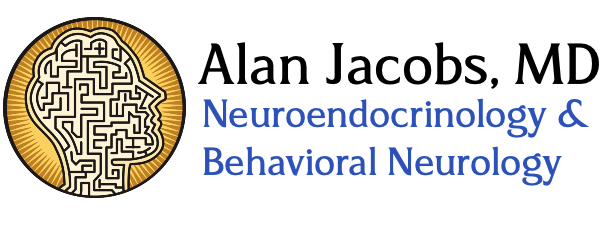I previously detailed 3 well-described patterns of catamenial symptoms that women report: Type 1 – premenstrual, Type 2 – peri-ovulatory (mid-cycle), and Type 3 – luteal (throughout the 2 weeks from midcycle to menses). Here I want to describe how and why the two reproductive hormones, estradiol (E2) and progesterone (P), have a yin / yang effect on the brain, so that these 3 patterns make sense.
Firstly, these hormones cause changes in our emotions and brain functioning by binding to specific docking sites (receptors) on specific brain cells in specific areas of the brain. Estradiol, the most potent estrogen, is the yin. When estradiol binds to its receptors on a brain cell, the brain cell fires faster and will use more glucose (sugar) and oxygen , its main fuels, faster. Estradiol also increases the flow of blood to the brain cell so more fuel can be delivered faster. These and many other similar effects make estrogen an energizing, mood elevating, “upper” type of hormone. However, too much of a good thing is a problem here also, since too much estradiol effect (“unopposed” by progesterone) can bring anxiety, agitation and even seizures.
Progesterone is the yang. It causes powerful restraints on a brain cell’s activity and firing rates and also decreases the number of estrogen receptors on the brain cells, therefore directly blocking estrogen’s effects. These and many other related effects give progesterone calming, relaxing, anti-seizure even tranquilizing properties. But, like we see in alcohol withdrawal (irritability, agitation, seizures), sudden withdrawal of progesterone can bring these same troubling excitatory symptoms.
The Type 1 (premenstrual) pattern is the most potent and common because two things are happening that cause trouble as the menstrual cycle comes to an end: 1) progesterone withdrawals after 2 weeks of being at a high level and 2) estradiol remains high for a few more days once progesterone levels start going down, therefore leading to “unopposed” estrogen effects. These two conditions occurring at the same time pack a double wallop of over-excitement.
The Type 2 (mid-cycle) pattern is caused by one main event; the “unopposed” surge of estradiol that triggers the release of the egg (ovulation), a few days before progesterone levels rise to block the estrogen effects.
The Type 3 (luteal) pattern is less common but lasts for two or more difficult weeks. Estrogen stays high after the mid-cycle surge, but the woman makes abnormally low levels of progesterone for the whole two weeks until menstruation. This 14 to 16 days of high estrogen and low progesterone feels like “unopposed estrogen” the whole time. The woman will report only one good week out of four (from cycle day #3 to day #10) without any seizures or agitating symptoms, when both hormone levels are very low in the bloodstream.
In general, women are very good at noticing the specific pattern of their catamenial symptoms, whether they be seizures or mood changes or the like. Our job as clinicians is to recognize and understand these patterns and help.

